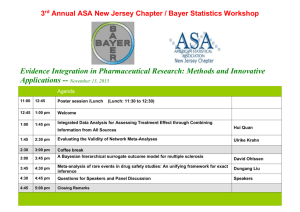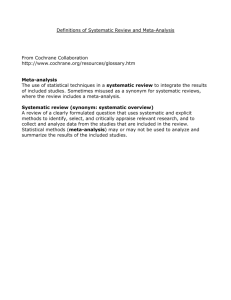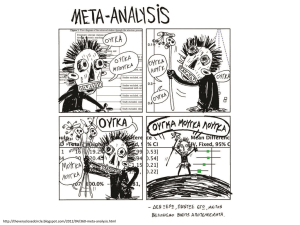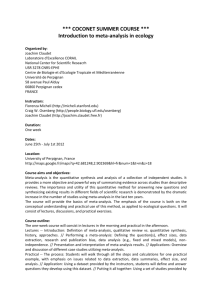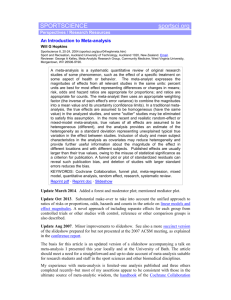Bassett Hall - Department of Statistical Science
advertisement
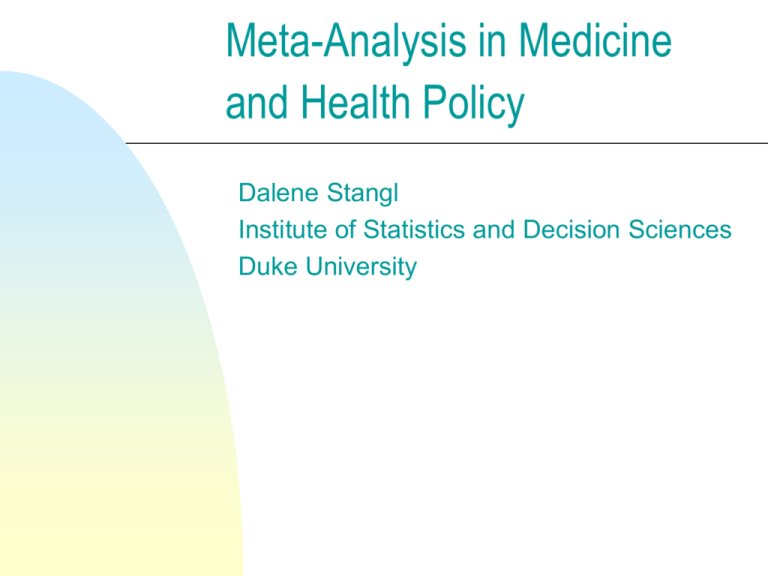
Meta-Analysis in Medicine and Health Policy Dalene Stangl Institute of Statistics and Decision Sciences Duke University Two Topics Directions of current research Gaps in current methologies Current Research shifting paradigms from fixed-effect to random-effect models incorporating inconsistency between study designs and between study outcomes assessing model uncertainty assessing and including measures of study quality and publication bias incorporating study-level covariates developing software Major Gap Decision process usually remains informal and ad hoc Two suggestions Train researchers and policy makers to specify utilities, or at least not use automatic 0/1 loss functions Demand analyses that demonstrate robustness to utility functions Example - hospital profiling Part I: Research Review Meta-Analysis in Medicine and Health Policy, Marcel Dekker Berry and Stangl (Eds.) Paradigm Shift 10 of 16 Chapters Meta-Analysis of Heterogeneously Reported Study Results – A Bayesian Approach Keith Abrams, Paul Lambert, Bruno Sanso, Chris Shaw, Theresa Marteau Meta-Analysis vs Large Trials: Resolving the Controversy Scott M. Berry A Bayesian meta-analysis of randomized mega-trials for the choice of thrombolytic agent in acute myocardial infarction James Brophy, Lawrence Joseph Combining Studies with Continuous and Dichotomous Responses: A Latent Variables Approach Francesca Dominici, Giovanni Parmigiani Computer Modeling and Graphical Strategies for Meta-Analysis William H. DuMouchel, Sharon-Lise T. Normand A Bayesian Meta-Analysis of the Relationship between Duration of Estrogen Exposure and Occurrence of Endometrial Cancer Daniel T. Larose Modeling and Implementation Issues in Bayesian Meta-Analysis Donna Pauler, Jon Wakefield An Application of Meta-Analysis to Population Pharmacokinetic data Nargis Rahman and Jonathan Wakefield Meta-analysis of Individual Patient Survival Data Using Random Effects Models Daniel J. Sargent, Benny Zee, Chantal Milan, Valter Torri, Guido Francini Adjustment for Publication and Quality Bias in Bayesian Metaanalysis D. D. Smith, Geof H. Givens, R. L. Tweedie Part I: Research Review Inconsistent Outcomes and Result Reporting Meta-Analysis of Heterogeneously Reported Study Results – A Bayesian Approach K. Abrams, P. Lambert, B. Sanso, C. Shaw, T. Marteau Combining Studies with Continuous and Dichotomous Responses: A Latent Variables Approach Francesca Dominici, Giovanni Parmigiani Part I: Research Review Model Uncertainty Computer Modeling and Graphical Strategies for Meta-Analysis William H. DuMouchel, Sharon-Lise T. Normand Part I: Research Review Study-level Covariates A Bayesian Meta-Analysis of Randomized Mega-Trials for the Choice of Thrombolytic Agent in Acute Myocardial Infarction James Brophy, Lawrence Joseph Computer Modeling and Graphical Strategies for MetaAnalysis William H. DuMouchel, Sharon-Lise T. Normand A Bayesian Meta-Analysis of the Relationship between Duration of Estrogen Exposure and Occurrence of Endometrial Cancer Daniel T. Larose Modeling and Implementation Issues in Bayesian MetaAnalysis Donna Pauler, Jon Wakefield Meta-Analysis of Individual Patient Survival Data Using Random-Effects Models D. Sargent, B. Zee, C. Milan, V. Torri, G. Francini Part I: Research Review Measures of study quality and publication bias Computer Modeling and Graphical Strategies for Meta-Analysis William H. DuMouchel, Sharon-Lise T. Normand Modeling and Implementation Issues in Bayesian Meta-Analysis Donna Pauler, Jon Wakefield Adjustment for Publication and Quality Bias in Bayesian Meta-analysis D. D. Smith, Geof H. Givens, R. L. Tweedie Part I: Research Review Software Meta-Analysis in Practice: ACritical Review of Available Software Alexander J. Sutton, Paul C. Lambert, Martin A. G. Hellmich, Keith R. Abrams, David. R. Jones Part II: Decision Analysis Gap Sir Claus Moser, 1975 Dorothy Price, Director, NCHS, 1976 “…. As in other areas of social policy, health statisticians and health data are increasingly expected to provide keys to rational decision making. To accomplish this goal, the statistician and decision maker need to interact to an increasing degree.” WHO, 1974 “foremost responsibility (of the statistician) is to contribute to more enlightened and efficient ‘decision making’ … through the fullest possible exploitation of our skills in analyzing and interpreting the data.” “The statistician must concern himself with policy-making. … supplier of the statistical information most relevant to the problem under consideration and as a skilled interpreter of the information, indicating the possible policy choices and the probable outcome of different strategies.” John Tukey, 1976 “…those statisticians for whom opportunity and a natural bent combine to offer experience and the development of expertise ought, in the public interest, become as much policy makers as their roles allow.” Part II: Decision Analysis Gap Commonalities All refer to importance of decision making Recommend more involvement of statisticians All statements were made 20-25 years ago Part II: Decision Analysis Gap 1970s-1980s development of a coordinated, systematic data base 1990s “Statistics and Policy” (Spencer, ed.) 10 chapters - data collection and descriptive statistics 4 chapters - statistics for policy analysis 0 chapters - statistics for decision making. Part II: Decision Analysis Gap Example - Hospital Profiling Paradigm Shift: Hierarchical Logistic Regression Outlier Identification Posterior probability of excess mortality for average patient adjusting for case mix. Posterior probability of a large difference between a hospital’s adjusted and standardized mortality. Z-score (HCFA’s algorithm) – hospitals with z-scores above 1.645 were classified as aberrant. Part II: Decision Analysis Gap Example - Hospital Profiling Embedded Utilities chosen outcome: mortality time point - 30 days relative performance measure median times 1.5 posterior probabilities – constant utilities Robustness??????? Part II: Decision Analysis Gap 2 Proposals relinquish the automatic constant utility embedded in p-values and posterior probabilities present statistical output in a way that increases the possibility and probability of applying a wide diversity of utility functions Part II: Decision Analysis Gap relinquish the automatic constant utility embedded in p-values and posterior probabilities i , Figure 1. i sufficient not sufficient Part II: Decision Analysis Gap Two decisions: d0: accept that the hospital is of sufficient quality d1: reject that the hospital is of sufficient quality U(d,) which measures utility of d when the uncertain value is U(d1,)>U(d0,) for > Part II: Decision Analysis Gap Figure 2. Constant Utility Function U(d0,) U(d1,) sufficient i not sufficient Figure 3. Linear Utility Function U(d0,) U(d1,) i sufficient not sufficient Figure 4. Compromise Utility Function U(d0,) U(d 1,) i sufficient not sufficient Part II: Decision Analysis Gap L()=U(d1,)-U(d0,) Figure 5. Constant Loss L()=(U(d1,)-U(d0,) sufficient Simplify Elicitations i Figure 6. Linear Loss L()=U(d1,)-U(d0,) not sufficient i sufficient Figure 7. Compromise Loss L()=U(d1,)-U(d0,) not sufficient i sufficient not sufficient Part II: Decision Analysis Gap Comparison of Loss Functions continuous/discontinuous derivative at is key for decision making second must elicit this quantity Part II: Decision Analysis Gap Extension to multivariate outcomes Tan & Smith (1998) Part II: Decision Analysis Gap 2nd Proposal present statistical output in a way that increases the possibility and probability of applying a wide diversity of utility functions predictive distributions for general outcomes • profiling example - predictive survival distributions • requires more sophisticated modeling • allows examination of diverse utilities References Berger, J.O. and Delampady, M. (1987). Testing precise hypotheses (with discussion). Statistical Science 2: 317-352. Berger, J.O. and Sellke, T. (1987). Testing a point-null hypothesis: the irreconcilability of p-values and evidence ( with discussion). J. Amer. Statistica Assoc. 82:112-139. Berger. R.L. and Hsu, J.C. (1996). Bioequivalence trials, intersection-union tests and equivalence confidence sets (with discussion). Statist. Sci. 11:283-319. Bernardo, J.M. and Smith, A.F.M. (1994). Bayesian Theory. Wiley. Chichester. Casella, G. and Berger, R.L. (1987). Reconciling Bayesian and frequentist evidence in the one-sided testing problem. J. Amer. Statist. Assoc. 82: 106-111. Cochran, W.G. (1976). The role of statistics in national health policy decisions. American Journal of Epidemiology 104(4):370-379. Lilford, R.J. and Thornton J.D. (1992). Decision logic in medical practice. Journal of the Royal College of Physicians of London, 26(4):400-412. Lilford, R.J. and Braudholtz, D. (1996). The statistical basis of public policy: a paradigm shift is overdue. British Medical Journal 313(7057):603-607. Lindley, D.V. (1985). Making Decisions. Wiley, Chichester. Lindley, D.V. (1997). The choice of sample size (with discussion). The Statistician 46: 129-166. Lindley, D.V. (1998). Decision Analysis and Bioequivalence Trials. Statistical Science 13(2): 136-141. Lindley, D.V. and Singpurwalla, N.D. (1991). On the evidence needed to reach agreed action between adversaries, with application to acceptance sampling. J. Amer. Statist. Assoc. 86: 933-937. Normand, S., Glickman, M., Gatsonis, C. (1997). Statistical methods for profiling providers of medical care: issues and applications. J. Amer. Statist. Assoc. 92(439):803-814. Paltiel, A.D. and Stinnett A.A. (1996). Making health policy decisions: Is human instinct rational? Is rational choice human? Chance 9(2):34-39. Rice, D. (1977). The role of statistics in the development of health care policy. The American Statistician 31(3):101-106. Tan S.B. and Smith, A.F.M. (1998). Exploratory thoughts on clinical trials with utilities. Statistics in Medicine 17:2771-2791. Tukey, J.W. (1976). Discussion of: “Role of statistics in national health policy decisions.” American Journal of Epidemiology 104(4):380-385. Slides for this talk will be at my website. www.stat.duke.edu -> Faculty -> Dalene Stangl -> Recent Talks ->Meta-Analysis in Medicine and Health Policy

